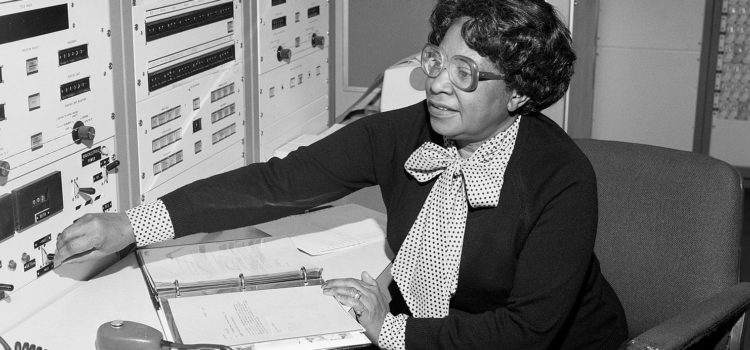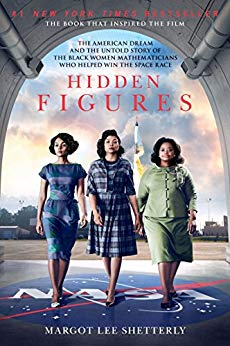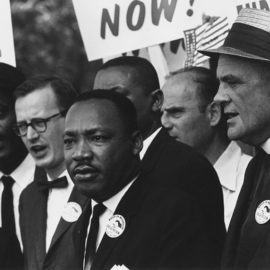

This article is an excerpt from the Shortform summary of "Hidden Figures" by Margot Lee Shetterly. Shortform has the world's best summaries of books you should be reading.
Like this article? Sign up for a free trial here .
Who were the first black women in NASA? What contributions did they make to space travel?
Amongst some of the first black women in NASA were Hidden Figures characters Dorothy Vaughan, Katherine Johnson, and Mary Jackson. Dorothy was one of the first black women in NASA, as she was hired during the war. The other two women joined later. With their many talented colleagues, they proudly worked in their roles, and they helped pave the way forward for other black women.
More Wartime Opportunities for Women
Women had been working as computers at Langley during the 1930s, but they would take on a far greater role at the laboratory during and after the war. By 1941, personnel officers at the lab were eagerly searching for more and more women (or “girls” as they were called at the time) to fill the new positions at Langley. Hiring agents scoured the East Coast for coeds who had any sort of mathematical background and placed job advertisements in newspapers in their endless quest for new talent.
At the same time, African-American leaders like A. Philip Randolph, head of the largest black labor union in the country, were pressuring the Roosevelt Administration to open up coveted jobs in the defense industry to black applicants. With two executive orders in 1941, FDR banned discriminatory hiring practices in the defense industry and opened the door for African-Americans to contribute to this growing and dynamic sector of the economy for the first time. This was what enabled black women to submit their applications to work at Langley—it was just a crack, but the door to opportunity was slowly starting to open to allow the first black women in NASA through.
Melvin Butler, the lab’s chief personnel officer, was a native Virginian who had grown up in the world of Jim Crow, but was also inherently practical and recognized the urgent need for new mathematical talent. While he recognized there would need to be a segregated space for the new black women, he also ensured that nothing was done to inhibit their arrival. The women would work in the warehouse building on the west side of the laboratory campus: the place would become known to history as West Area Computing.
“Colored Computing”
When Dorothy Vaughan arrived at Langley, the bus dropped her off at the West Area of the campus, the space that had been reserved for the new black, female computers (the East Area was set aside for their white counterparts). She found that her new colleagues shared her background in the world of black colleges, alumni associations, and churches. Despite the prejudices and limited opportunities that existed at the time even for white women, these black women had all landed jobs at the world’s premier aeronautical research institution.
White women (former East Area Computers) oversaw the West Computers, parceling out tasks to the various section heads, who in turn subdivided the work among the women in their section of the computing pool. What the women of West Computing were usually working on was a portion of a larger task, some quick piece of calculation that an engineer required for a bigger project.
Langley was a place where colleagues worked closely with one another (often literally close, thanks to the wartime hiring spree) and clerks and computers might rub shoulders with top aeronautics researchers. Yet, for the first black women in NASA because of the color of their skin, the West Area Computers were largely excluded from this collegial atmosphere. Although Executive Order 8802 had mandated fair employment in the defense industry, Langley’s location in the Commonwealth of Virginia forced it to comply with that state’s segregation statutes.
This was symbolized most hurtfully by the sign on the table where they sat at the back of the cafeteria that read, “COLORED COMPUTERS.” Although they were ostensibly professionals on par with their colleagues at Langley, they were still treated as something less than equal.
Changes at NACA and Rising in the Ranks
By the mid-1950s, NACA was beginning to introduce mechanical computers into its laboratory spaces. Companies like Bell Telephone Laboratories and IBM were supplying the government with the first generation of mechanical data-processing machines (though they weren’t yet digital, but analog; their output came in the form of paper punch cards). They weren’t totally reliable and still produced lots of errors that needed to be corrected by the female mathematicians, but they could process data at a speed that was impossible for humans to match—and, critically, they could be left to run overnight after the staff had gone home.
The female mathematicians’ jobs weren’t immediately placed in jeopardy, but the most astute among them, like Katherine, could certainly see the writing on the wall—that mastering these powerful machines would be essential to future success at Langley. For the first black women in NASA, the message was clear: in order to keep their jobs, they had to adapt.
In addition to mastering the machines in the laboratory, Katherine and her peers would need to master another machine, one that dominated the social, economic, and political order of the South—the machine of Jim Crow. It would need to be smashed, defeated, and consigned to the ash heap of history if African-Americans were ever to advance and be seen as equals. This was all happening at a critical time for race relations in America.
Mary Jackson
Mary was invited by “Kaz” Czarnecki to work on the Supersonic Pressure Tunnel. Mary quickly distinguished herself while working on the SPT unit. One day, she was asked to perform some calculations on supersonic and hypersonic research for John Becker, a powerful and important division chief at Langley. Mary deftly delivered her calculations to Becker, fully confident that she had performed them correctly. Becker refused to accept them, however, insisting that something was wrong with Mary’s numbers.
But she stood by her work. There was an error in the numbers—but it was Becker’s, not Mary’s. He had given her the wrong numbers to input, but Mary had performed her calculations flawlessly. Becker apologized, and Mary earned a reputation as a trusted and capable mathematician. She was marked as someone who deserved to move ahead.
Katherine Johnson
Katherine was selected as a mathematician in the Space Task Group, who was responsible for launching a man into orbit.
Katherine had to process the numbers generated by the proposed trajectories over and over, re-calculating the figures every time any slight detail in the flightpath was changed.
There was zero room for error, as everything needed to be calibrated perfectly in order to launch the craft and return the astronaut safely. Katherine’s ballistic trajectory tables would determine whether or not the returning astronaut would land near enough to the waiting navy ships to be speedily scooped out of the sea and brought to safety.
But Katherine, as ever, was undaunted by the task. She had proven herself an incomparable mathematician and a quick study with the higher-level conceptual work. She was straightforward with her bosses, telling them, “Tell me where you want the man to land, and I’ll tell you where to send him up.”
Dorothy Vaughan
One of the first black women in NASA, Dorothy Vaughan rapidly ascended the ranks at Langley. As more and more women were hired at the now-integrated West Computing to replace those who had been reassigned to specialized divisions, she transitioned into a managerial role. In 1949, the laboratory director appointed her head of West Computing, a position she would hold for the next decade.
The End of West Computing
The expanded mission and scope of NASA wrought major changes for the agency, transforming it into a high-profile bureaucracy with twice as many employees as it had before. It also signaled the end of an era for West Computing. Skill specialization was now the key to success at NASA: there was simply less of a need for a centralized pool like West Computing. Many of the original West Computers had already moved out of the pool, being assigned to mission-focused projects and divisions elsewhere at the laboratory. By the time NASA shuttered the West Area Computers Unit in 1958, only nine remained, including Dorothy Vaughan. Some of the first black women in NASA remained, even if their unit did not. Their contributions remained.
In subsequent years, Dorothy would reinvent herself as an early computer programmer, mastering the IBM 704. She performed the vital task of translating engineers’ data and entering it into the computer in its FORTRAN language. Dorothy’s work at Langley had helped her fulfill many of her ambitions. Her children were off to college, and she had bought a home of her own. And she had shepherded so many of her “girls” onto fulfilling careers of their own. But this was a bittersweet moment for Dorothy. As she passed the torch to a new generation of black women, she also recognized that she would be taking a back seat. Her days as a manager were over. At NASA, she would be just one of the girls again.
Cementing the Legacy
As the years and decades wore on, it became clear that the women of West Computing (which had ceased operations in the late 1950s) had left an indelible mark on NASA, the struggle for African-American civil rights, and the United States itself. Facing down racism and segregation, these women had turned their temporary wartime jobs into permanent and fulfilling careers. The first black women in NASA had succeeded in fulfilling their dreams, and turned their attention to helping other young black women do the same.
Their years at Langley would be marked by watershed moments in the fight for civil rights—the Brown v. Board of Education decision, the 1963 March on Washington for Jobs and Freedom, and the passage of the Civil Rights Act and the Voting Rights Act. As pioneers, the West Computers had opened the doors for people of color who would follow in their footsteps. Mary Jackson always made a point of welcoming new black employees, helping them find places to live and offering them a home-cooked meal when they were homesick.
She, along with women like Katherine Johnson, created an informal network of older black women who helped new minority employees make the transition to the agency. In doing so, they midwifed the careers of a generation of black engineers and scientists, including Christine Mann (later Christine Darden), who knew Katherine Johnson through a friendship with the latter’s daughter. Mary Jackson being named Federal Women’s Program Manager was the natural fulfillment of a career defined by helping girls and women of all colors advance.
When, on July 20, 1969, the men of the Apollo 11 mission walked on the surface of the Moon, it was the fulfillment of many things—President Kennedy’s 1961 challenge, the hopes and dreams of a nation, and decades of research, advocacy, and struggle on the part of NASA’s black scientists and engineers. That night, Katherine Johnson watched the landing on television, transfixed by the marvel of human achievement she was witnessing, and her, and the role of the other first black women in NASA, in bringing it to fruition.
As she watched and listened to Neil Armstrong describe mankind’s historic leap, she thought of the men and women who had made her own journey possible—Dorothy Vaughan, Dr. Claytor, A. Phillip Randolph, her parents. From a little girl who used to gaze up in wonder at the sky, she was now the engineer who sent men to touch the face of the heavens and walk where no one had walked before.
The story of Katherine and her fellow West Computers is one of hope, of triumph over the harshest adversity. It is also one of empowerment—these women exercised real agency and control over the course of their lives. They were protagonists who acted upon America and shaped its destiny, protagonists in the great drama of the nation’s history.
The first black women in NASA helped pave the way for men and women of color at the organization. They were dedicated to their work and to their cause, and they fought tirelessly for an equal workplace—in addition to the small task of launching people into space.

———End of Preview———
Like what you just read? Read the rest of the world's best summary of Margot Lee Shetterly's "Hidden Figures" at Shortform .
Here's what you'll find in our full Hidden Figures summary :
- How brave black women were instrumental to the American space race
- How they confronted racism and sexism to forge a better future
- Their enduring legacy in American history






